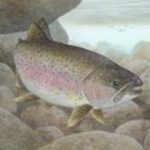If you have spent any time at all fishing for rainbow trout, you are probably well aware of the fact that fishing for these beautiful fish during the wintertime can be a bit of a challenge. That is of course unless you are fishing through the ice, where the trout fishing can be quite productive at times. But what about if your prefer to fish for rainbow trout in the flowing waters of a river or stream? Is it even worth bundling up and heading out in the winter?
Well, that depends on how much of you enjoy the act of fishing for rainbow trout. If you enjoy all the aspects of fishing for rainbow trout such as the smells in the air, the sounds of the river, and the serenity that comes from standing in a flowing river or stream, then the winter is definitely a time of the year that you should try fishing for some rainbows. During the winter the sights and sounds can be nothing short of breathtaking and are something eevery serious trout fisherman needs to experience.
The first factor to consider is that you are not going to experience the same success that you do during the more hospitable seasons. For example, during the spring, summer, and fall I personally expect to catch 3-10 trout every time that I head out fishing. During the winter I revise this number to 1 or 2 trout. This way my expectations aren’t all out of whack, because I know that fishing for rainbow trout in the winter is much less productive than at other times of the year.
The next factor to consider is the size of the bait or lure that you are going to use. The size of your bait or lure, just like your expectations, should be downsized. My friends who fly fish know this rule well, as the winter is known as “nymphing” time to many of them. For those of you who don’t know, a nymph, is a very small artificial fly. Well, this same rule applies to spin fishermen who are looking to catch a few winter rainbow trout. Use spinners and jigs that are as small as you can effectively cast and live baits such as maggots, grubs, or meal worms as bait during the winter months.
Finally, no matter what type of bait or lure you choose to use, make sure that you slow down your presentation as much as possible. Rainbows are very sluggish when the water temperature drops into the high thirties, so any meal that they eat needs to be moving as slowly as they are. Keep these simple tips in mind the next time that you head out in search of winter rainbow trout. You will not only experience more success, you will also enjoy yourself much more.




